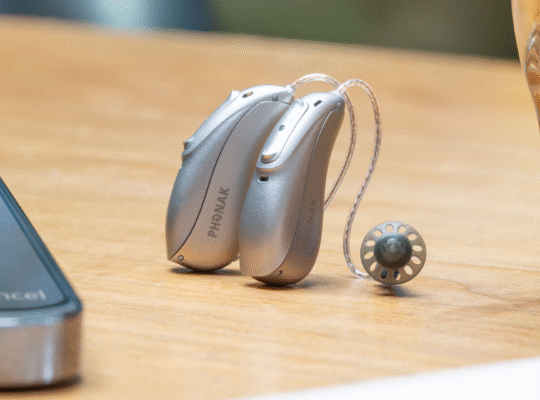Tympanometer. It almost sounds like an instrument from a science fiction movie or something you use to tune satellites. In reality, it is a medical device that means a lot to your hearing and ear health. It is used by audiologists, ENT doctors and sometimes general practitioners to examine how well your eardrum and middle ear are functioning.
But what exactly does a tympanometer do? Why should you have such a test done? And what do the results actually say? Time to explore the world of air pressure, eardrums and beeps.
What is a tympanometer?
A tympanometer is a device that measures the mobility of your eardrum. The eardrum is a thin membrane that collects sound vibrations and transmits them to the ossicles in your middle ear. If something is wrong with that membrane, or if there are problems in the middle ear (such as fluid or a blockage of the Eustachian tube), your hearing can be quite affected.
The great thing is that the tympanometer can detect all that without cutting or poking your ear. It is a completely painless examination, although it can sometimes feel a little strange.
How does the research work?
The examination with a tympanometer is called tympanometry. During the test, the specialist places a soft, cone-shaped cap in your ear. This cap is connected to the device and seals your ear canal airtight.
A small amount of air pressure is then put into your ear while the device emits a soft beep. The eardrum responds to that change in pressure by moving inward or outward. The tympanometer measures how smoothly and quickly that happens.
The result is shown in a graph – a tympanogram – that allows the specialist to see whether your eardrum is moving normally, is too stiff or too flexible.
Why is eardrum movement so important?
Your eardrum is like the gateway for sound to your middle ear. When the membrane can move smoothly, sound vibrations are properly transmitted to the ossicles and then to the cochlea in your inner ear.
But if the eardrum is too tight, for example, due to inflammation or fluid behind the eardrum, those vibrations are muffled and you hear worse. The same is true if the eardrum is actually too weak, such as after a hole or damage.
What can a tympanometer detect?
A tympanometer is especially useful in detecting:
- Moisture behind the eardrum (for example, after a middle ear infection)
- Blockage of the Eustachian tube, causing pressure in the middle ear not to be properly regulated
- Damage or scarring of the eardrum
- Rigid ossicles(otosclerosis)
- Too much suppleness, such as from a ruptured eardrum
So the device can tell a lot, but it does not provide a complete diagnosis. Usually the doctor or audiologist uses the results as part of a broader hearing examination.
The feeling during the test
For most people, tympanometry does not feel painful, but it does feel a little strange. You may feel a slight pressure in your ear, as if you were on an airplane and your ears “pop.” The beep the device emits is soft, but clearly audible.
Children sometimes find it exciting, but it usually only takes a few seconds per ear. Often it helps if the parent explains that the “ear will be tested for a while with a special measuring dummy” – that does sound a little friendlier.
Tympanometry in children
In children, tympanometry is often used to check for fluid behind the eardrum, something that is common in young children. This fluid can cause hearing loss and, if left for a long time, affect speech and language development.
The test is so short and simple that it is easily performed even in toddlers and preschoolers. Sometimes it is even done as part of a routine checkup in children who have had many ear infections.
The results: a chart full of information
After the test, a graph rolls out of the device. It looks like a kind of hill or just a flat line.
- Type A: a nice sharp peak in the middle – this means the eardrum is moving normally.
- Type B: a flat line – often a sign of fluid behind the eardrum or a hole in the eardrum.
- Type C: the peak is far to the left – this usually indicates negative pressure in the middle ear, often due to problems with the Eustachian tube.
The specialist combines this information with other tests and your symptoms to reach a conclusion.
What happens after the examination?
If the results are normal, it can be reassuring: your eardrum is working as it should. If there are abnormalities, the doctor may decide on further testing or treatment. This can range from prescribing medication to placing eardrum tubes in children.
Sometimes tympanometry is also repeated to see if a treatment is effective. For example, after placing tubes or after a course of antibiotics for an ear infection.
Why not everyone has a tympanometer in their closet
Although the device is indispensable in hearing care, it is not a do-it-yourself tool. Reading and interpreting the graph requires experience and knowledge. Moreover, the measurement is reliable only if the ear is free of earwax, as this can affect the result. Therefore, the test is always done by someone trained in it.
Benefits of tympanometry
- Painless and fast
- Provides immediate insight into the condition of the middle ear
- Suitable for all ages
- Can be repeated without risk
- Helps detect ear problems that might be missed with a hearing test alone
Restrictions
Although the test can measure a lot, it tells nothing about the functioning of the inner ear or the auditory nerve. For that, other tests are needed, such as a tone audiogram. So a normal tympanometry does not automatically mean your hearing is perfect – but it is an important step in the examination.
In conclusion
A tympanometer may have a complicated name, but it’s actually a very friendly device that can tell you a lot about your ears in a matter of seconds. Whether you suffer from a pressing sensation, have frequent ear infections, or just want to know if your eardrum is still moving smoothly: this test can provide a lot of clarity.
So should you ever get a small cap in your ear at an audiologist or ENT doctor’s office and hear a soft beep, now you know: you’re getting acquainted with the tympanometer – your ears will be pleased.








